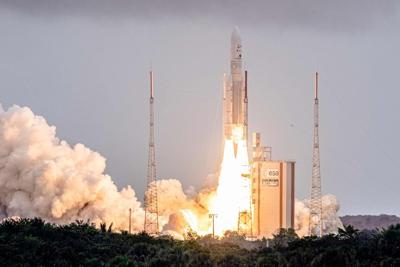In May of 2020, an 18-tonne piece of a Chinese Long March 5B rocket plummeted from orbit. Torn to shreds in the atmosphere, the debris ã including a 12-metre-long pipe ã smashed into two villages in Ivory Coast, damaging several buildings.
The incident was not the first case of rocket bodies crashing into populated regions, and it wonãt be the last, experts say.
With a booming space industry seeing more rockets blasting off than ever, researchers from the University of British Columbia warn itãs only a matter of time before an avoidable death by falling space junk.
Their ãconservativeã estimates place the risk at between six to ten per cent over the coming decade.
ãTechnologies already exist to ensure that no more rocket stages are abandoned in orbit,ã said Michael Byers, the paperãs lead author, co-director of the Outer Space Institute and professor of international relations at UBC. ãThe numbers (of abandoned rocket bodies) are continuing to rise at a time when that simply doesn’t need to happen.ã
His teamãs paper, published Monday in , combed through 30 years of data from a public satellite database to predict the risk of death or severe injury from the uncontrolled re-entry of abandoned rocket parts over the next decade.
ãJust as a matter of good science, we ran two separate models,ã Byers said. ãOne came out with a six per cent risk, the other one came out with a ten per cent risk.ã
Byers explained that these were ãconservative estimates,ã and that they didnãt account for factors like the ãworst case scenarioã of a rocket part hitting an airplane carrying hundreds of passengers.
The team also discovered countries in the southern hemisphere were far more likely to be struck by rocket impacts. Major cities like Jakarta, Dhaka and BogotûÀ are at least three times more likely to be hit than New York, Beijing and Moscow, their paper reads.
ãThis was the surprise outcome of the research for us,ã Byers said.
His team believes this is because most rocket bodies are abandoned to orbit near the equator, where much of the worldãs population is concentrated.
Unfortunately, most spacefaring nations are in the Global North, meaning ãthe risk is borne by the populations of countries that are not even contributing to the risk,ã Byers said.
ãThere’s a history of developed northern countries exporting risk to the Global South and this is just another example of that,ã he added.
This risk is also entirely avoidable. The technology exists to dispose of rocket bodies instead of abandoning them in orbit ã for example, used-up rocket stages could be packed with extra fuel, enabling scientists to steer them harmlessly into the ocean, Byers said. SpaceX has even managed to recycle their used rockets by landing them back on Earth.
With all this in mind, Byersãs team is vouching for the creation of an ãinternational regime for controlled rocket re-entry,ã he said ã an international regulatory body looking over the risks of rocket re-entry.
Some standards already exist, but they vary from country to country and are often waived. In the U.S., for example, launches are required to have a less than one in 10,000 chance of causing a casualty on rocket re-entry.
Between 2011 and 2018, the U.S. Air Force waived the standards for conducted for it, reasoning that it was too expensive to swap out non-compliant rockets for compliant ones. NASA waived the standards between 2008 and 2018, including one flight with a casualty risk of one in 600.
Even ignoring some nationsã habits of waiving standards, weãve come to a point where the standards themselves have become outdated, said Aaron Boley, a co-author on the paper, co-director of the Outer Space Institute and professor of physics and astronomy at UBC.
ãWe need to look at the cumulative riskã of rocket re-entry versus looking at launches from a case to case basis, Boley said.
He explained that while the individual risk of single rocket launches may be small, it adds up when you factor in the ever-increasing amount of launches every year, and the steadily growing mass of rocket and satellite infrastructure in orbit.
ãThe cumulative effects of all these launches are now at the stage where there needs to be a consideration for how we dispose of the material in orbit, because somebody could get hurt,ã he said.
If we donãt, there could be geopolitical consequences.
ãIf the material comes down and it kills a family, if it does serious damage to some very important infrastructure ã that’s going to create an international incident,ã Boley said.
ãThat then could cause a lot of economic damage, because there might be a halt to launches while things are investigated,ã he continued.
Boley pointed to the 1989 Exxon Valdez oil spill as an example. Both oil spills and fatal rocket crashes are seen as rare events, with relatively loose regulations to begin with, he said. But when Exxon Valdez spilled roughly 11 million gallons of oil in Alaskaãs Prince William Sound, the incident was major enough for the U.S. to mandate all new tankers to have double hulls.
Boley sees the same thing happening if or when someone dies from falling space debris ã governments will be forced to act and regulate.
ãSo yeah, this is unlikely to happen, but given enough time, it will,ã he said. ãAnd when it does happen, there will be sudden changes that can be very damaging to the industry.ã
ãGetting in front of this is really an important step for the longevity of the industry, as well as the safety of the people.ã



















To join the conversation set a first and last name in your user profile.
Sign in or register for free to join the Conversation